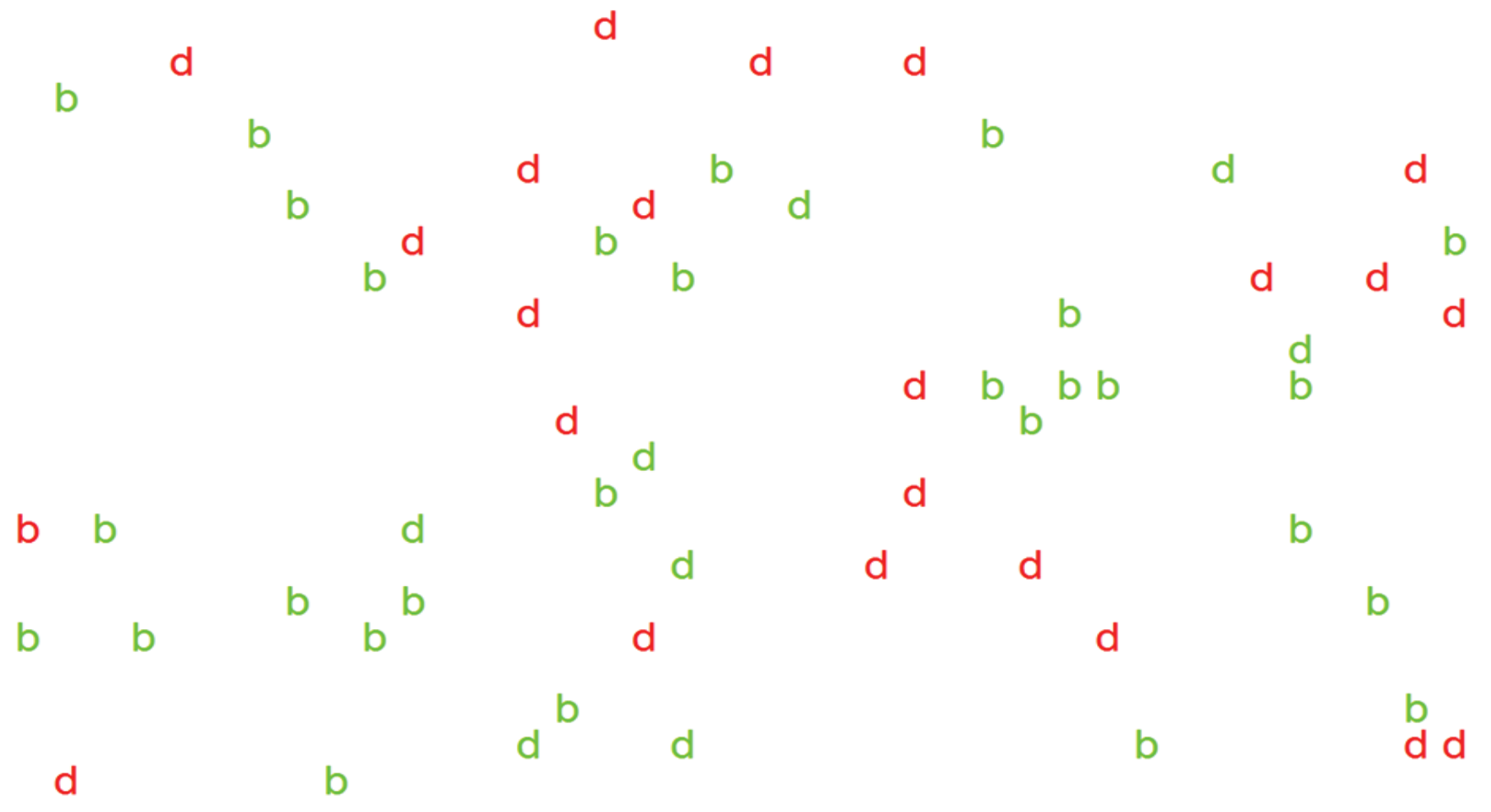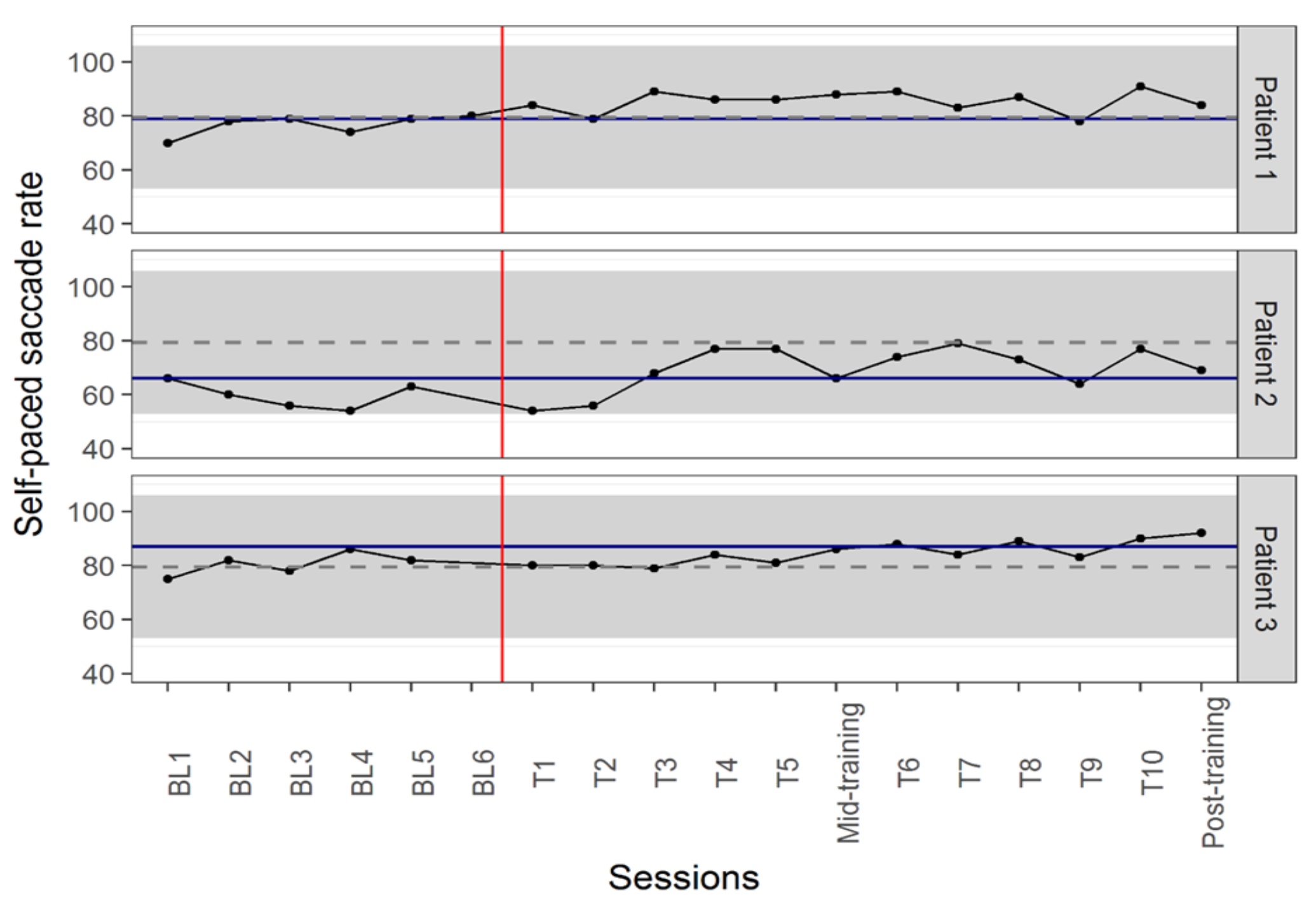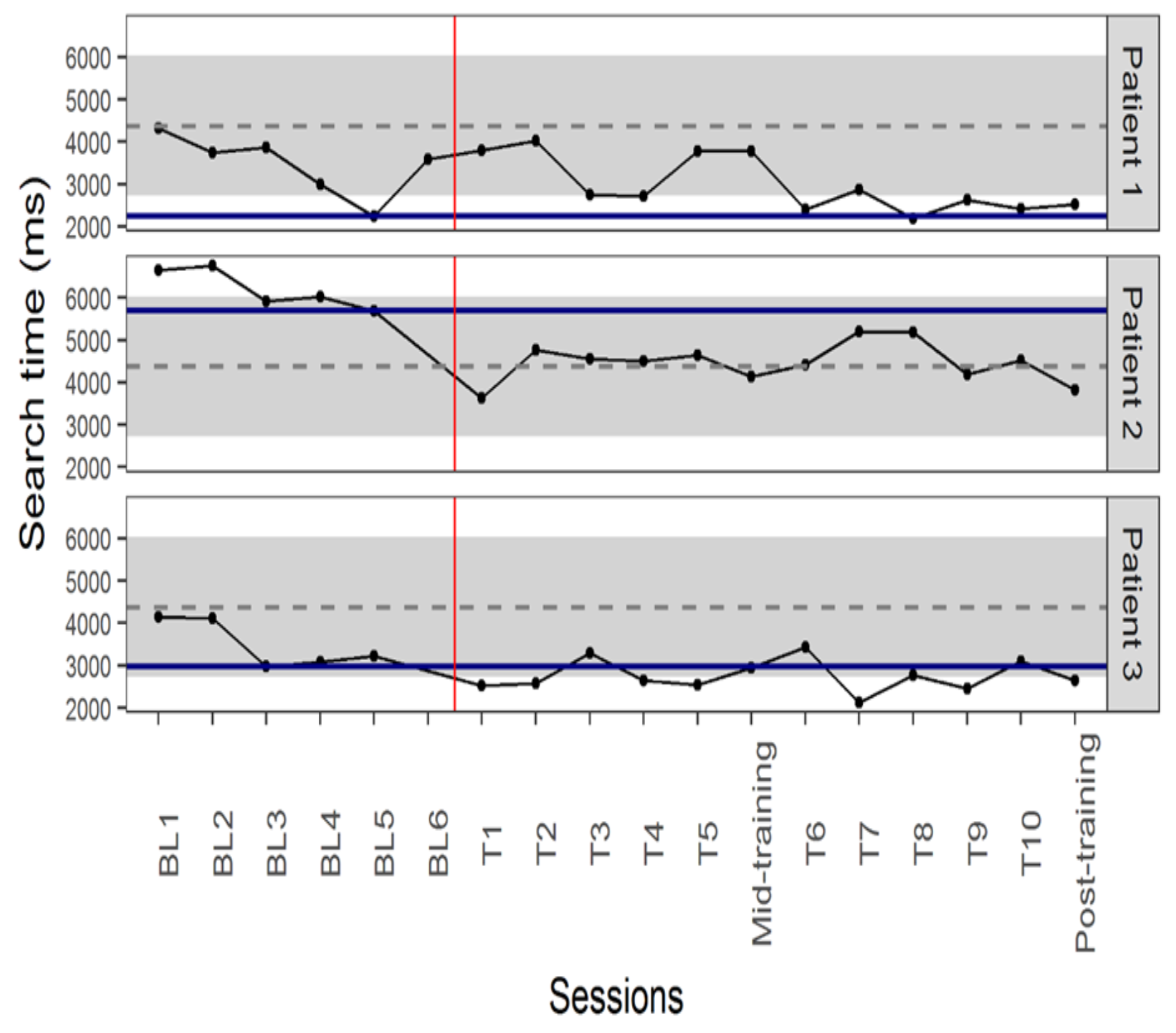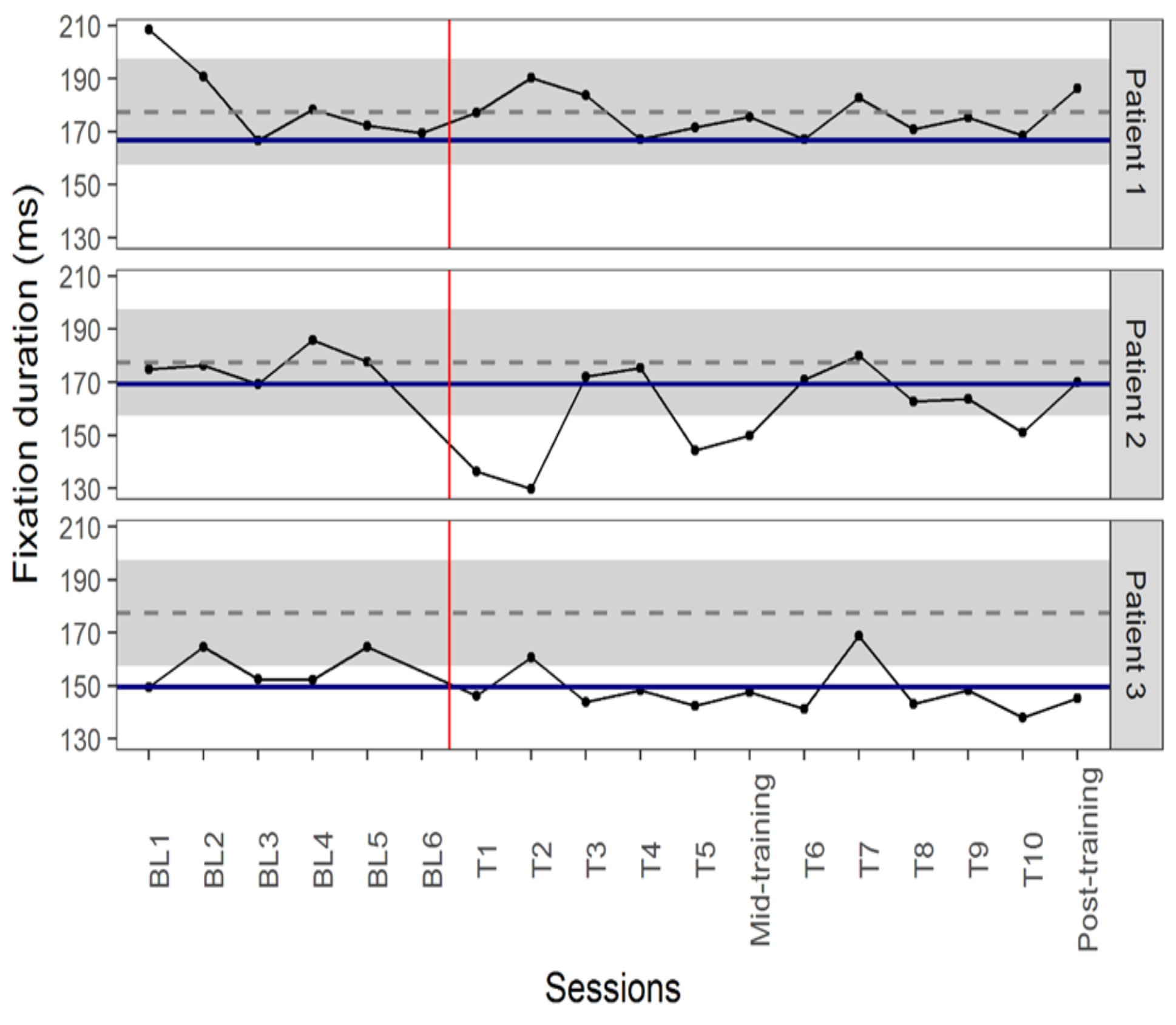Video Game Training in Traumatic Brain Injury Patients: An Exploratory Case Report Study Using Eye Tracking
Abstract
:Introduction
Present study
Methods
Participants
Patient 1:
Patient 2:
Patient 3:
Apparatus and stimuli
Self-paced saccades
Abstract conjunctive visual search task
Procedure
Testing procedure
Training procedure
Analysis
Results
Game performance
Self-paced saccades
Abstract visual search
Search time
Fixation duration (FD)
Discussion
Patient 1
Patient 2
Patient 3
General Discussion
Limitations
Conclusion
Ethics and Conflict of Interest
References
- Abel, L. A., and J. Douglas. 2007. Effects of age on latency and error generation in internally mediated saccades. Neurobiology of Aging 28, 4: 627–637. [Google Scholar] [CrossRef] [PubMed]
- Achtman, R. L., C. S. Green, and D. Bavelier. 2008. Video games as a tool to train visual skills. Restorative Neurology & Neuroscience 26, 4/5: 435–446. [Google Scholar]
- Alresheed, F., B. L. Hott, and C. Bano. 2013. Single Subject Research: A Synthesis of Analytic Methods. Journal of Special Education Apprenticeship 2, 1: n1. [Google Scholar] [CrossRef]
- Anguera, J. A., J. Boccanfuso, J. L. Rintoul, O. Al-Hashimi, F. Faraji, J. Janowich, E. Kong, Y. Larraburo, C. Rolle, and E. Johnston. 2013. Video game training enhances cognitive control in older adults. Nature 501, 7465: 97–101. [Google Scholar] [CrossRef]
- Azizi, E., L. A. Abel, and M. J. Stainer. 2017. The influence of action video game playing on eye movement behaviour during visual search in abstract, in-game and natural scenes. Attention, Perception & Psychophysics 79, 2: 484–497. [Google Scholar]
- Belchior, P., M. Marsiske, S. M. Sisco, A. Yam, D. Bavelier, K. Ball, and W. C. Mann. 2013. Video game training to improve selective visual attention in older adults. Computers in Human Behavior 29, 4: 1318–1324. [Google Scholar] [CrossRef]
- Biscaldi, M., B. Fischer, and V. Stuhr. 1996. Human express saccade makers are impaired at suppressing visually evoked saccades. Journal of Neurophysiology 76, 1: 199–214. [Google Scholar] [CrossRef]
- Bohnen, N., J. Jolles, and A. Twijnstra. 1992. Neuropsychological deficits in patients with persistent symptoms six months after mild head injury. Neurosurgery 30, 5: 692–696. [Google Scholar]
- Brouwer, W. H., M. Verzendaal, J. van der Naalt, J. Smit, and A. H. van Zomeren. 2001. Divided attention years after severe closed head injury: The effect of dependencies between the subtasks. Brain and Cognition 46, 1: 54–56. [Google Scholar] [CrossRef]
- Cannonieri, G. C., L. Bonilha, P. T. Fernandes, F. Cendes, and L. M. Li. 2007. Practice and perfect: length of training and structural brain changes in experienced typists. Neuroreport 18, 10: 1063–1066. [Google Scholar] [CrossRef]
- Cicerone, K. D., D. Cynthia, F. M. James, M. L. Donna, F. Thomas, K. Sally, E. Wendy, K. Kathleen, T. G. Joseph, H. J. Preston, L. Linda, A. M. Philip, and C. Jeanne. 2005. Evidence-Based Cognitive Rehabilitation: Updated Review of the Literature From 1998 Through 2002. Archives of Physical Medicine and Rehabilitation 86, 8: 1681–1692. [Google Scholar] [PubMed]
- Cicerone, K. D., D. M. Langenbahn, C. Braden, J. F. Malec, K. Kalmar, M. Fraas, T. Felicetti, L. Laatsch, H. J. Preston, T. Bergquist, J. Azulay, J. Cantor, and T. Ashman. 2011. Evidence-Based Cognitive Rehabilitation: Updated Review of the Literature From 2003 Through 2008. Archives of Physical Medicine and Rehabilitation 92, 4: 519–530. [Google Scholar] [CrossRef]
- Corrigan, J. D., and J. Bogner. 2007. Initial reliability and validity of the Ohio State University TBI identification method. The Journal of head trauma rehabilitation 22, 6: 318–329. [Google Scholar]
- Dinse, H. R., G. H. Recanzone, and M. M. Merzenich. 1993. Alterations in correlated activity parallel ICMS-induced representational plasticity. Neuroreport 5, 2: 173–176. [Google Scholar] [CrossRef]
- Donoghue, J. P. 1995. Plasticity of adult sensorimotor representations. Current Opinion in Neurobiology 5, 6: 749–754. [Google Scholar]
- Dye, M. W. G., and D. Bavelier. 2010. Differential development of visual attention skills in school-age children. Vision Research 50, 4: 452–459. [Google Scholar] [CrossRef] [PubMed]
- Dye, M. W. G., C. S. Green, and D. Bavelier. 2009b. Increasing speed of processing with action video games. Current Directions in Psychological Science 18, 6: 321–326. [Google Scholar] [CrossRef]
- Elbert, T., C. Pantev, C. Wienbruch, B. Rockstroh, and E. Taub. 1995. Increased cortical representation of the fingers of the left hand in string players. Science 270, 5234: 305–307. [Google Scholar] [PubMed]
- Feng, J., I. Spence, and J. Pratt. 2007. Playing an action video game reduces gender differences in spatial cognition. Psychological Science 18, 10: 850–855. [Google Scholar] [CrossRef]
- Franceschini, S., S. Gori, M. Ruffino, S. Viola, M. Molteni, and A. Facoetti. 2013. Action video games make dyslexic children read better. Current Biology 23, 6: 462–466. [Google Scholar]
- Green, C. S., and D. Bavelier. 2003. Action video game modifies visual selective attention. Nature 423, 6939: 534–537. [Google Scholar] [PubMed]
- Green, C. S., and D. Bavelier. 2006a. Effect of action video games on the spatial distribution of visuospatial attention. Journal of Experimental Psychology: Human Perception and Performance 32, 6: 1465–1478. [Google Scholar]
- Green, C. S., and D. Bavelier. 2006b. Enumeration versus multiple object tracking: the case of action video game players. Cognition 101, 1: 217–245. [Google Scholar] [PubMed]
- Green, C. S., and D. Bavelier. 2008. Exercising your brain: a review of human brain plasticity and traininginduced learning. Psychology and Aging 23, 4: 692–701. [Google Scholar]
- Heitger, M. H., T. J. Anderson, R. D. Jones, J. C. DalrympleAlford, C. M. Frampton, and M. W. Ardagh. 2004. Eye movement and visuomotor arm movement deficits following mild closed head injury. Brain 127, 3: 575–590. [Google Scholar]
- Heitger, M. H., R. D. Jones, A. D. Macleod, D. L. Snell, C. M. Frampton, and T. J. Anderson. 2009. Impaired eye movements in post-concussion syndrome indicate suboptimal brain function beyond the influence of depression, malingering or intellectual ability. Brain 132, 10: 2850–2870. [Google Scholar]
- Heitger, M. H., M. R. Macaskill, R. D. Jones, and T. J. Anderson. 2005. The impact of mild closed head injury on involuntary saccadic adaptation: Evidence for the preservation of implicit motor learning. Brain Injury 19, 2: 109–117. [Google Scholar]
- Henderson, J. M., C. C. Williams, M. S. Castelhano, and R. J. Falk. 2003. Eye movements and picture processing during recognition. Perception & Psychophysics 65, 5: 725–734. [Google Scholar]
- Hoffman, J. E., and B. Subramaniam. 1995. The role of visual attention in saccadic eye movements. Perception & Psychophysics 57, 6: 787–795. [Google Scholar]
- Hogendoorn, H. 2016. Voluntary saccadic eye movements ride the attentional rhythm. Journal of Cognitive Neuroscience 28, 10: 1625–1635. [Google Scholar]
- Hooge, I. T. C., and C. J. Erkelens. 1999. Peripheral vision and oculomotor control during visual search. Vision Research 39, 8: 1567–1575. [Google Scholar]
- Horner, R. H., E. G. Carr, J. Halle, G. McGee, S. Odom, and M. Wolery. 2005. The use of single-subject research to identify evidence-based practice in special education. Exceptional children 71, 2: 165–179. [Google Scholar]
- Hubert-Wallander, B., C. S. Green, M. Sugarman, and D. Bavelier. 2011. Changes in search rate but not in the dynamics of exogenous attention in action videogame players. Attention, Perception, & Psychophysics 73, 8: 2399–2412. [Google Scholar]
- Hunfalvay, M., C.-M. Roberts, N. Murray, A. Tyagi, H. Kelly, and T. Bolte. 2019. Horizontal and vertical self-paced saccades as a diagnostic marker of traumatic brain injury. Concussion 4, 1: CNC60. [Google Scholar] [PubMed]
- James, W. 1890. The perception of reality. Principles of psychology 2: 283–324. [Google Scholar]
- Jeon, S. T., D. Maurer, and T. L. Lewis. 2012. The effect of video game training on the vision of adults with bilateral deprivation amblyopia. Seeing and Perceiving 25, 5: 493–520. [Google Scholar]
- Kazdin, A. E., and A. H. Tuma. 1982. Single-case research designs.
- Koepp, M. J., R. N. Gunn, A. D. Lawrence, V. J. Cunningham, A. Dagher, T. Jones, D. J. Brooks, C. J. Bench, and P. Grasby. 1998. Evidence for striatal dopamine release during a video game. Nature 393, 6682: 266–268. [Google Scholar]
- Kowler, E., E. Anderson, B. Dosher, and E. Blaser. 1995. The role of attention in the programming of saccades. Vision Research 35, 13: 1897–1916. [Google Scholar]
- Krasny-Pacini, A., and J. Evans. 2018. Single-case experimental designs to assess intervention effectiveness in rehabilitation: A practical guide. Annals of Physical and Rehabilitation Medicine 61, 3: 164–179. [Google Scholar]
- Kratochwill, T. R., and J. R. Levin. 2015. Single-Case Research Design and Analysis (Psychology Revivals): New Directions for Psychology and Education. Routledge. [Google Scholar]
- Kraus, M. F., D. M. Little, A. J. Donnell, J. L. Reilly, N. Simonian, and J. A. Sweeney. 2007. Oculomotor function in chronic traumatic brain injury. Cognitive and Behavioral Neurology 20, 3: 170–178. [Google Scholar]
- Kroll, A., M. Mak, and J. Samochowiec. 2016. Learning to search. The importance of eye movements in the decrease of response times during a visual choice reaction time task. Journal of Eye Movement Research 9, 5. [Google Scholar]
- Kühn, S., D. T. Kugler, K. Schmalen, M. Weichenberger, C. Witt, and J. Gallinat. 2019. Does playing violent video games cause aggression? A longitudinal intervention study. Molecular Psychiatry 24, 8: 1220–1234. [Google Scholar]
- Kuhn, S., R. Lorenz, T. Banaschewski, G. J. Barker, C. Büchel, P. J. Conrod, H. Flor, H. Garavan, B. Ittermann, E. Loth, K. Mann, F. Nees, E. Artiges, T. Paus, M. Rietschel, M. N. Smolka, A. Ströhle, B. Walaszek, G. Schumann, and A. Heinz. 2014. Positive Association of Video Game Playing with Left Frontal Cortical Thickness in Adolescents. PLoS ONE 9, 3: e91506. [Google Scholar]
- Larose, S., S. Gagnon, C. Ferland, and M. Pépin. 1989. Psychology of computers: XIV. Cognitive rehabilitation through computer games. Perceptual And Motor Skills 69, 3: 851–858. [Google Scholar] [PubMed]
- Levin, H. S., D. H. Williams, H. M. Eisenberg, W. M. High, and F. C. Guinto. 1992. Serial MRI and neurobehavioural findings after mild to moderate closed head injury. Journal of Neurology, Neurosurgery & Psychiatry 55, 4: 255–262. [Google Scholar]
- Li, R. W., C. Ngo, J. Nguyen, and D. M. Levi. 2011. Video-game play induces plasticity in the visual system of adults with amblyopia. PLoS-Biology 9, 8: e1001135. [Google Scholar]
- Lobel, E., P. Kahane, U. Leonards, M. H. Grosbras, S. Lehéricy, D. L. Bihan, and A. Berthoz. 2001. Localization of human frontal eye fields: anatomical and functional findings of functional magnetic resonance imaging and intracerebral electrical stimulation. Journal Of Neurosurgery 95, 5: 804–815. [Google Scholar]
- Mack, D. J., and U. J. Ilg. 2014. The effects of video game play on the characteristics of saccadic eye movements. Vision Research 102: 26–32. [Google Scholar]
- Maguire, E. A., D. G. Gadian, I. S. Johnsrude, C. D. Good, J. Ashburner, R. S. Frackowiak, and C. D. Frith. 2000. Navigation-related structural change in the hippocampi of taxi drivers. Proceedings of the National Academy of Sciences 97, 8: 4398–4403. [Google Scholar]
- Mateer, C., M. M. Sohlberg, and P. K. Youngman. 1990. The management of acquired attention and memory deficits. Cognitive Rehabilitation in Perspective, 68–95. [Google Scholar]
- McDowell, J. E., K. A. Dyckman, B. P. Austin, and B. A. Clementz. 2008. Neurophysiology and neuroanatomy of reflexive and volitional saccades: Evidence from studies of humans. Brain and Cognition 68, 3: 255–270. [Google Scholar] [CrossRef] [PubMed]
- Montani, V., M. D. F. De Grazia, and M. Zorzi. 2014. A new adaptive videogame for training attention and executive functions: design principles and initial validation.
- Mulhall, L. E., I. M. Williams, and L. A. Abel. 1999. Bedside tests of saccades after head injury. Journal of Neuro-ophthalmology: the Official Journal of the North American Neuro-ophthalmology Society 19, 3: 160–165. [Google Scholar]
- Oei, A. C., and M. D. Patterson. 2013. Enhancing cognition with video games: a multiple game training study. PLoS ONE 8, 3: e58546. [Google Scholar]
- Petit, L., C. Orssaud, N. Tzourio, F. Crivello, A. Berthoz, and B. Mazoyer. 1996. Functional anatomy of a prelearned sequence of horizontal saccades in humans. The Journal of Neuroscience 16, 11: 3714–3726. [Google Scholar]
- Ponsford, J., and G. Kinsella. 1992. Attentional deficits following closed-head injury. Journal of Clinical and Experimental Neuropsychology 14, 5: 822–838. [Google Scholar] [PubMed]
- Robertson, I. H., T. Ward, V. Ridgeway, and I. NimmoSmith. 1994. The test of everyday attention (TEA). Bury St. Edmunds, UK: Thames Valley Test Company, pp. 197–221. [Google Scholar]
- Romeiser-Logan, L., R. Slaughter, and R. Hickman. 2017. Single-subject research designs in pediatric rehabilitation: a valuable step towards knowledge translation. Developmental Medicine and Child Neurology 59, 6: 574–580. [Google Scholar] [CrossRef]
- Scruggs, T. E., M. A. Mastropieri, and G. Casto. 1987. The quantitative synthesis of single-subject research methodology and validation. Remedial and Special Education 8, 2: 24–33. [Google Scholar]
- Segal, K. R., and W. H. Dietz. 1991. Physiologic responses to playing a video game. American Journal of Diseases of Children 145, 9: 1034–1036. [Google Scholar] [PubMed]
- Shapiro, K. L., J. E. Raymond, and K. M. Arnell. 1997. The attentional blink. Trends in Cognitive Sciences 1, 8: 291–296. [Google Scholar]
- Smith, D. H., D. F. Meaney, and W. H. Shull. 2003. Diffuse axonal injury in head trauma. Journal of Head Trauma Rehabilitation 18, 4: 307–316. [Google Scholar]
- Sohlberg, M. M., J. Avery, M. Kennedy, M. Ylvisaker, C. Coelho, L. Turkstra, and K. Yorkston. 2003. Practice guidelines for direct attention training. Journal of Medical Speech-Language Pathology 11, 3: xix–xix. [Google Scholar]
- Sparks, D. L. 2002. The brainstem control of saccadic eye movements. Nature Reviews Neuroscience 3, 12: 952–964. [Google Scholar]
- Spikman, J. M., B. G. Deelman, and A. H. van Zomeren. 2000. Executive functioning, attention and frontal lesions in patients with chronic CHI. Journal of Clinical and Experimental Neuropsychology 22, 3: 325–338. [Google Scholar] [PubMed]
- Spikman, J. M., A. H. van Zomeren, and B. G. Deelman. 1996. Deficits of attention after closed-head injury: slowness only? Journal of Clinical and Experimental Neuropsychology 18, 5: 755–767. [Google Scholar]
- Taghdiri, F., J. Chung, S. Irwin, N. Multani, A. Tarazi, A. Ebraheem, M. Khodadadi, R. Goswami, R. Wennberg, and D. Mikulis. 2018. Decreased number of self-paced saccades in post-concussion syndrome associated with higher symptom burden and reduced white matter integrity. Journal of Neurotrauma 35, 5: 719–729. [Google Scholar]
- Vakili, A., and R. Langdon. 2016. Cognitive rehabilitation of attention deficits in traumatic brain injury using action video games: A controlled trial. Cogent Psychology 3. [Google Scholar]
- Van der Stigchel, S., and T. C. Nijboer. 2011. The global effect: what determines where the eyes land? Journal of Eye Movement Research 4, 2. [Google Scholar]
- Vassallo, S., and J. Douglas. 2021. Visual scanpath training to emotional faces following severe traumatic brain injury: A single case design. Journal of Eye Movement Research 14, 4. [Google Scholar]
- Wienrich, C., U. Heße, and G. Müller-Plath. 2009. Eye movements and attention in visual feature search with graded target-distractor-similarity. Journal of Eye Movement Research 3, 1. [Google Scholar] [CrossRef]
- Williams, I. M., J. L. Ponsford, K. L. Gibson, L. E. Mulhall, C. A. Curran, and L. A. Abel. 1997. Cerebral control of saccades and neuropsychological test results after head injury. Journal of Clinical Neuroscience 4, 2: 186–196. [Google Scholar] [CrossRef]
- Withaar, F. K., and W. H. Brouwer. 2003. Divided attention after closed head injury. Zeitschrift fur Neuropsychologie 14, 3: 203–211. [Google Scholar]
- Wolfe, J. M. 1994. Guided search 2.0 a revised model of visual search. Psychonomic Bulletin & Review 1, 2: 202–238. [Google Scholar]
- Wu, S., and I. Spence. 2013. Playing shooter and driving videogames improves top-down guidance in visual search. Attention, Perception, & Psychophysics 75, 4: 673–686. [Google Scholar]




Copyright © 2022. This article is licensed under a Creative Commons Attribution 4.0 International License.
Share and Cite
Azizi, E.; Fielding, J.; Abel, L.A. Video Game Training in Traumatic Brain Injury Patients: An Exploratory Case Report Study Using Eye Tracking. J. Eye Mov. Res. 2022, 15, 1-14. https://doi.org/10.16910/jemr.15.1.6
Azizi E, Fielding J, Abel LA. Video Game Training in Traumatic Brain Injury Patients: An Exploratory Case Report Study Using Eye Tracking. Journal of Eye Movement Research. 2022; 15(1):1-14. https://doi.org/10.16910/jemr.15.1.6
Chicago/Turabian StyleAzizi, Elham, Joanne Fielding, and Larry A. Abel. 2022. "Video Game Training in Traumatic Brain Injury Patients: An Exploratory Case Report Study Using Eye Tracking" Journal of Eye Movement Research 15, no. 1: 1-14. https://doi.org/10.16910/jemr.15.1.6
APA StyleAzizi, E., Fielding, J., & Abel, L. A. (2022). Video Game Training in Traumatic Brain Injury Patients: An Exploratory Case Report Study Using Eye Tracking. Journal of Eye Movement Research, 15(1), 1-14. https://doi.org/10.16910/jemr.15.1.6


